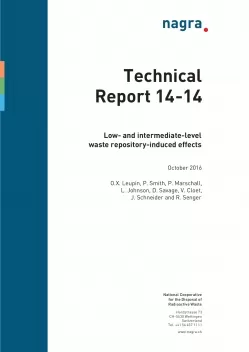
Technical Report NTB 14-14
Low- and intermediate-level waste repository-induced effects
This status report aims at describing and assessing the interactions of the radioactive waste emplaced in a low- and intermediate level waste (L/ILW) repository with the engineered materials and the Opalinus Clay host rock. The Opalinus Clay has a thickness of about 100 m in the proposed siting regions. Among other things the results are used to steer the RD&D programme of Nagra. The repository-induced effects considered in this report are of the following broad types:
- Thermal effects: i.e. effects arising principally from the heat generated by the waste and the setting of cement
- Rock-mechanical effects: i.e. effects arising from the mechanical disturbance to the rock caused by the excavation of the emplacement caverns and other underground structures
- Hydraulic and gas-related effects: i.e. the effects of repository resaturation and of gas generation, e.g. due to the corrosion of metals within the repository, on the host rock and engineered barriers
- Chemical effects: i.e. chemical interactions between the waste, the engineered materials and the host rock
Deep geological repositories are designed to avoid or mitigate the impact of potentially detrimental repository-induced effects on long-term safety. For the repository under consideration in the present report, an assessment of those repository-induced effects that remain shows that detrimental chemical and mechanical impacts are largely confined to the rock adjacent to the excavations, thermal impacts are minimal and gas effects can be mitigated by appropriate design measures to reduce gas production and provide pathways for gas transport that limit gas pressure build-up (engineered gas transport system, or EGTS). Specific measures that are part of the current reference design are discussed in relation to their significance with respect to repository-induced effects.
The disposal system described in this report provides a system of passive barriers with multiple safety functions. The disposal system has been designed to perform with sufficient safety margin for a range of siting conditions. The barriers include the host rock, its surrounding geological setting, the waste forms, drums and the cementitious backfill. They have a range of attributes that intrinsically favour safety and that avoid or minimise detrimental phenomena and uncertainties or mitigate their effects. Nevertheless, potentially detrimental repository-induced effects remain and in the present report, these are investigated and discussed considering a broad spectrum of parameters, reflecting, among other things, the range of potential siting conditions.
The L/ILW emplacement caverns are designed, constructed, operated and finally backfilled in such a way that formation of excavation damaged zones is limited. Specifically this is achieved by restricting the size of the excavations and the depth of the repository, using a low-deformation, controlled construction and excavation method and by the fact that the excavations will be backfilled relatively soon after construction with grain supported mortar. At expected repository depths, the caverns will need to be supported to ensure stability and worker protection; this will prevent rock falls and further extension of the EDZ. Based on the modelling results, it can be concluded that the extent of the EDZ around the L/ILW emplacement caverns will not exceed a thickness of one cavern diameter and that the hydraulic conductance of the EDZ around the emplacement caverns, access tunnels and shafts will not exceed a value of 10-7 m3/s. Self-sealing of the EDZ and low hydraulic gradients along the tunnels will result in negligible radionuclide transport by the EDZ pathway.
It is shown that gas pressure build-up is controlled by the gas transport capacity of the pathways between the main repository and the access tunnel forming the so-called EGTS. Results obtained with the sensitivity cases for a repository depth of 500 m bgl indicate that the EGTS can be designed in such a way that gas pressures which could damage the repository and/or the host rock will not be reached.
When designing and assessing the performance of a L/ILW repository, the relevant chemical interactions are taken into account. With the current reference design, it is expected that degradation of the cementitious backfill, the concrete tunnel liner and the corrosion of the steel drums and other supporting structures will lead to some alteration of the cementitious nearfield and Opalinus Clay. These detrimental effects are taken into account in dose calculations and have been found not to have a significant impact on the calculated dose rates.
